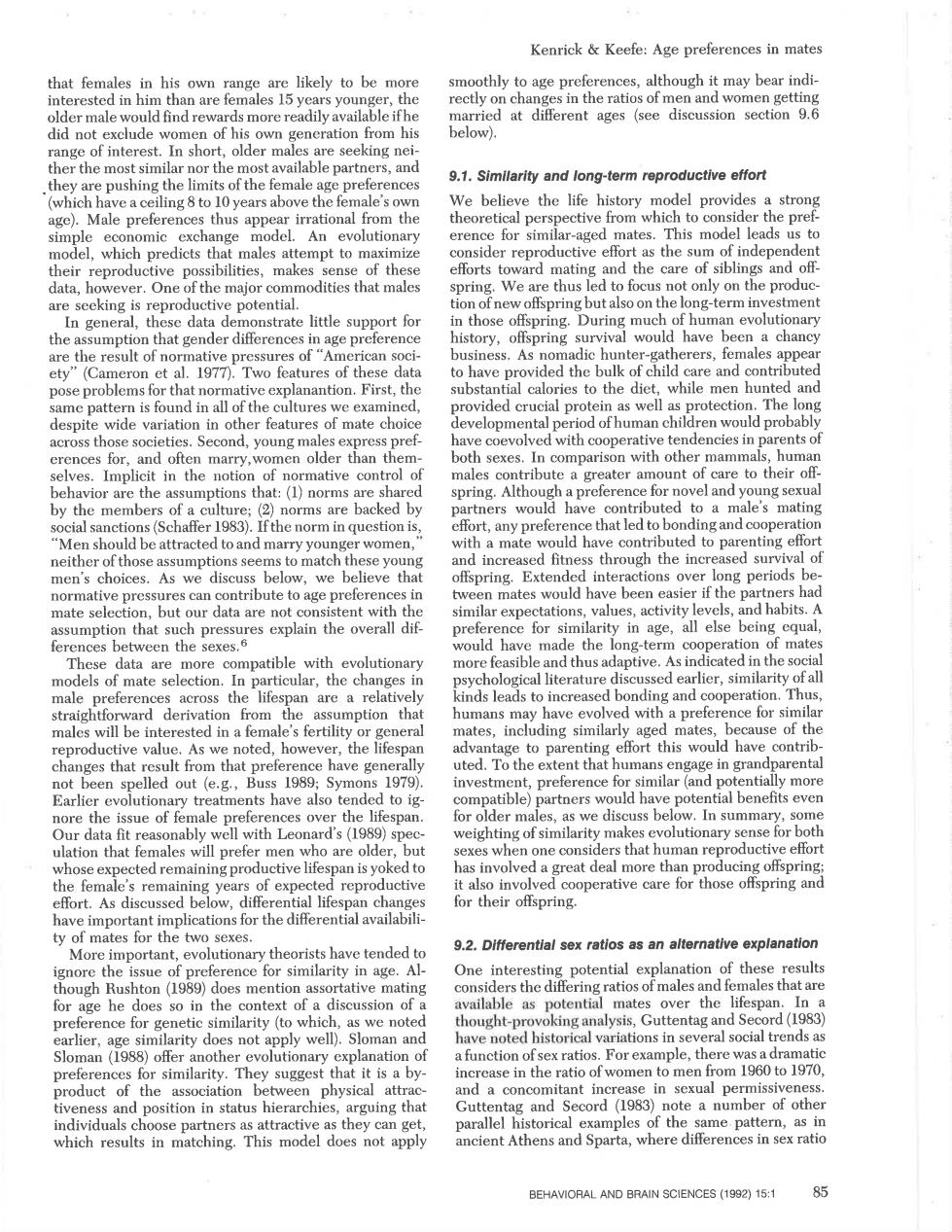
Kenrick Keefe:Age preferences in mates that females in his own range are likely to be more smoothly to age preferences,although it may bear indi- interested in him than are females 15 years younger,the rectly on changes in the ratios of men and women getting older male would find rewards more readily available ifhe married at different ages (see discussion section 9.6 did not exclude women of his own generation from his below). range of interest.In short,older males are seeking nei- ther the most similar nor the most available partners,and 9.1.Similarity and long-term reproductive effort they are pushing the limits of the female age preferences (which have a ceiling 8 to 10 years above the female's own We believe the life history model provides a strong age).Male preferences thus appear irrational from the theoretical perspective from which to consider the pref- simple economic exchange model.An evolutionary erence for similar-aged mates.This model leads us to model,which predicts that males attempt to maximize consider reproductive effort as the sum of independent their reproductive possibilities,makes sense of these efforts toward mating and the care of siblings and off- data,however.One of the major commodities that males spring.We are thus led to focus not only on the produc- are seeking is reproductive potential. tion of new offspring but also on the long-term investment In general,these data demonstrate little support for in those offspring.During much of human evolutionary the assumption that gender differences in age preference history,offspring survival would have been a chancy are the result of normative pressures of "American soci- business.As nomadic hunter-gatherers,females appear ety"(Cameron et al.1977).Two features of these data to have provided the bulk of child care and contributed pose problems for that normative explanantion.First,the substantial calories to the diet,while men hunted and same pattern is found in all of the cultures we examined, provided crucial protein as well as protection.The long despite wide variation in other features of mate choice developmental period of human children would probably across those societies.Second,young males express pref- have coevolved with cooperative tendencies in parents of erences for,and often marry,women older than them- both sexes.In comparison with other mammals,human selves.Implicit in the notion of normative control of males contribute a greater amount of care to their off- behavior are the assumptions that:(1)norms are shared spring.Although a preference for novel and young sexual by the members of a culture;(2)norms are backed by partners would have contributed to a male's mating social sanctions(Schaffer 1983).If the norm in question is, effort,any preference that led to bonding and cooperation "Men should be attracted to and marry younger women, with a mate would have contributed to parenting effort neither of those assumptions seems to match these young and increased fitness through the increased survival of men's choices.As we discuss below,we believe that offspring.Extended interactions over long periods be- normative pressures can contribute to age preferences in tween mates would have been easier if the partners had mate selection,but our data are not consistent with the similar expectations,values,activity levels,and habits.A assumption that such pressures explain the overall dif- preference for similarity in age,all else being equal, ferences between the sexes.6 would have made the long-term cooperation of mates These data are more compatible with evolutionary more feasible and thus adaptive.As indicated in the social models of mate selection.In particular,the changes in psychological literature discussed earlier,similarity of all male preferences across the lifespan are a relatively kinds leads to increased bonding and cooperation.Thus, straightforward derivation from the assumption that humans may have evolved with a preference for similar males will be interested in a female's fertility or general mates,including similarly aged mates,because of the reproductive value.As we noted,however,the lifespan advantage to parenting effort this would have contrib- changes that result from that preference have generally uted.To the extent that humans engage in grandparental not been spelled out (e.g.,Buss 1989;Symons 1979). investment,preference for similar(and potentially more Earlier evolutionary treatments have also tended to ig- compatible)partners would have potential benefits even nore the issue of female preferences over the lifespan. for older males,as we discuss below.In summary,some Our data fit reasonably well with Leonard's(1989)spec- weighting of similarity makes evolutionary sense for both ulation that females will prefer men who are older,but sexes when one considers that human reproductive effort whose expected remaining productive lifespan is yoked to has involved a great deal more than producing offspring; the female's remaining years of expected reproductive it also involved cooperative care for those offspring and effort.As discussed below,differential lifespan changes for their offspring. have important implications for the differential availabili- ty of mates for the two sexes. More important,evolutionary theorists have tended to 9.2.Differential sex ratios as an alternative explanation ignore the issue of preference for similarity in age.Al- One interesting potential explanation of these results though Rushton(1989)does mention assortative mating considers the differing ratios of males and females that are for age he does so in the context of a discussion of a available as potential mates over the lifespan.In a preference for genetic similarity(to which,as we noted thought-provoking analysis,Guttentag and Secord(1983) earlier,age similarity does not apply well).Sloman and have noted historical variations in several social trends as Sloman(1988)offer another evolutionary explanation of a function ofsex ratios.For example,there was a dramatic preferences for similarity.They suggest that it is a by- increase in the ratio of women to men from 1960 to 1970, product of the association between physical attrac- and a concomitant increase in sexual permissiveness. tiveness and position in status hierarchies,arguing that Guttentag and Secord (1983)note a number of other individuals choose partners as attractive as they can get, parallel historical examples of the same pattern,as in which results in matching.This model does not apply ancient Athens and Sparta,where differences in sex ratio BEHAVIORAL AND BRAIN SCIENCES(1992)15:1 85
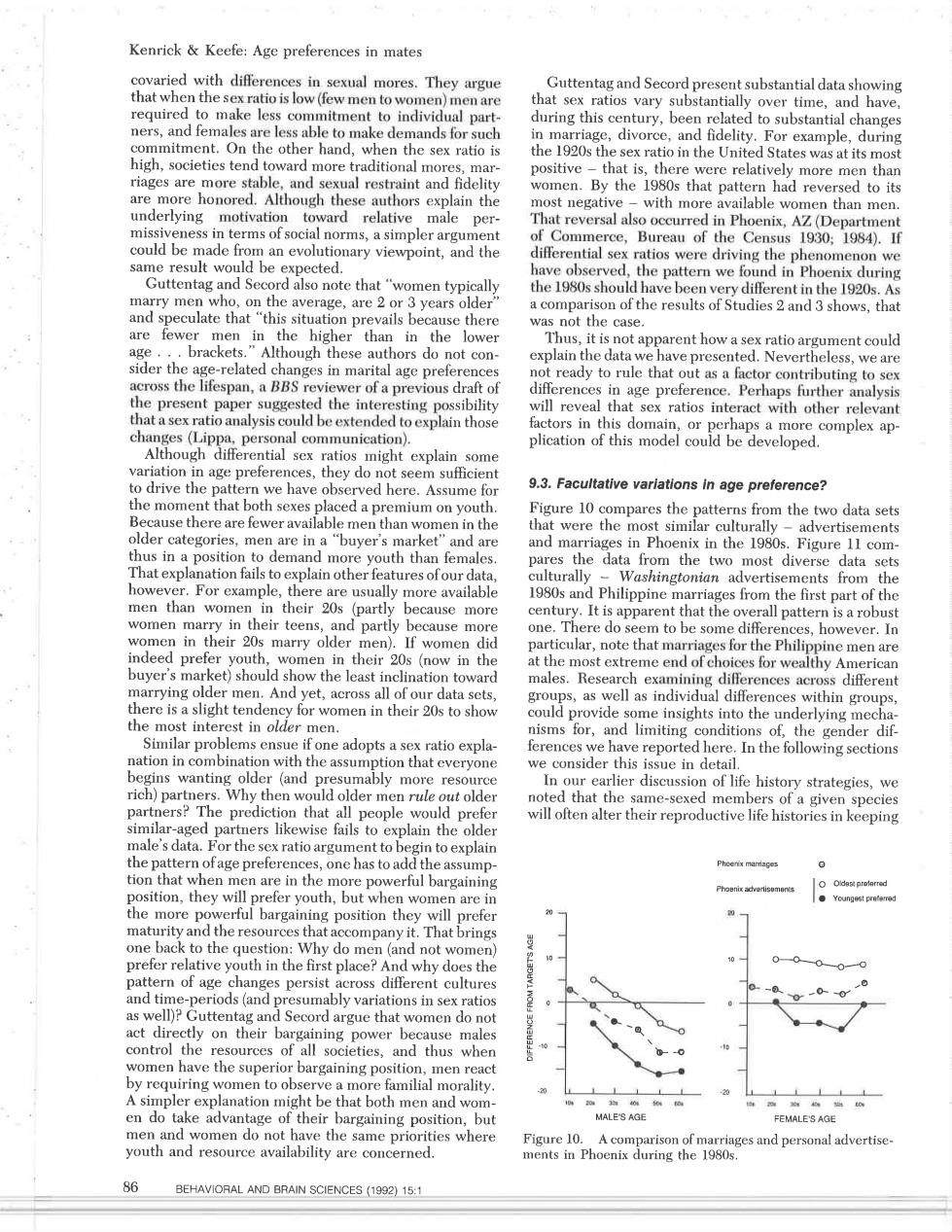
Kenrick Keefe:Age preferences in mates covaried with differences in sexual mores.They argue Guttentag and Secord present substantial data showing that when the sex ratio is low (few men to women)men are that sex ratios vary substantially over time,and have, required to make less commitment to individual part- during this century,been related to substantial changes ners,and females are less able to make demands for such in marriage,divorce,and fidelity.For example,during commitment.On the other hand,when the sex ratio is the 1920s the sex ratio in the United States was at its most high,societies tend toward more traditional mores,mar- positive-that is,there were relatively more men than riages are more stable,and sexual restraint and fidelity women.By the 1980s that pattern had reversed to its are more honored.Although these authors explain the most negative-with more available women than men. underlying motivation toward relative male per- That reversal also occurred in Phoenix,AZ(Department missiveness in terms of social norms,a simpler argument of Commerce,Bureau of the Census 1930;1984).If could be made from an evolutionary viewpoint,and the differential sex ratios were driving the phenomenon we same result would be expected. have observed,the pattern we found in Phoenix during Guttentag and Secord also note that"women typically the 1980s should have been very different in the 1920s.As marry men who,on the average,are 2 or 3 years older' a comparison of the results of Studies 2 and 3 shows,that and speculate that"this situation prevails because there was not the case. are fewer men in the higher than in the lower Thus,it is not apparent how a sex ratio argument could age...brackets."Although these authors do not con- explain the data we have presented.Nevertheless,we are sider the age-related changes in marital age preferences not ready to rule that out as a factor contributing to sex across the lifespan,a BBS reviewer of a previous draft of differences in age preference.Perhaps further analysis the present paper suggested the interesting possibility will reveal that sex ratios interact with other relevant that a sex ratio analysis could be extended to explain those factors in this domain,or perhaps a more complex ap- changes (Lippa,personal communication) plication of this model could be developed. Although differential sex ratios might explain some variation in age preferences,they do not seem sufficient to drive the pattern we have observed here.Assume for 9.3.Facultative variations in age preference? the moment that both sexes placed a premium on youth. Figure 10 compares the patterns from the two data sets Because there are fewer available men than women in the that were the most similar culturally -advertisements older categories,men are in a "buyer's market"and are and marriages in Phoenix in the 1980s.Figure 11 com- thus in a position to demand more youth than females. pares the data from the two most diverse data sets That explanation fails to explain other features ofour data culturally -Washingtonian advertisements from the however.For example,there are usually more available 1980s and Philippine marriages from the first part of the men than women in their 20s (partly because more century.It is apparent that the overall pattern is a robust women marry in their teens,and partly because more one.There do seem to be some differences,however.In women in their 20s marry older men).If women did particular,note that marriages for the Philippine men are indeed prefer youth,women in their 20s (now in the at the most extreme end of choices for wealthy American buyer's market)should show the least inclination toward males.Research examining differences across different marrying older men.And yet,across all of our data sets, groups,as well as individual differences within groups, there is a slight tendency for women in their 20s to show could provide some insights into the underlying mecha- the most interest in older men. nisms for,and limiting conditions of,the gender dif- Similar problems ensue if one adopts a sex ratio expla- ferences we have reported here.In the following sections nation in combination with the assumption that everyone we consider this issue in detail. begins wanting older (and presumably more resource In our earlier discussion of life history strategies,we rich)partners.Why then would older men rule out older noted that the same-sexed members of a given species partners?The prediction that all people would prefer will often alter their reproductive life histories in keeping similar-aged partners likewise fails to explain the older male's data.For the sex ratio argument to begin to explain the pattern ofage preferences,one has to add the assump- Phoenix marriages tion that when men are in the more powerful bargaining Oldest prelnrred position,they will prefer youth,but when women are in the more powerful bargaining position they will prefer maturity and the resources that accompany it.That brings one back to the question:Why do men (and not women) prefer relative youth in the first place?And why does the pattern of age changes persist across different cultures and time-periods(and presumably variations in sex ratios as well)?Guttentag and Secord argue that women do not act directly on their bargaining power because males control the resources of all societies,and thus when women have the superior bargaining position,men react by requiring women to observe a more familial morality. A simpler explanation might be that both men and wom- en do take advantage of their bargaining position,but MALE'S AGE FEMALE'S AGE men and women do not have the same priorities where Figure 10.A comparison of marriages and personal advertise- youth and resource availability are concerned. ments in Phoenix during the 1980s. 86 BEHAVIORAL AND BRAIN SCIENCES (1992)15:1
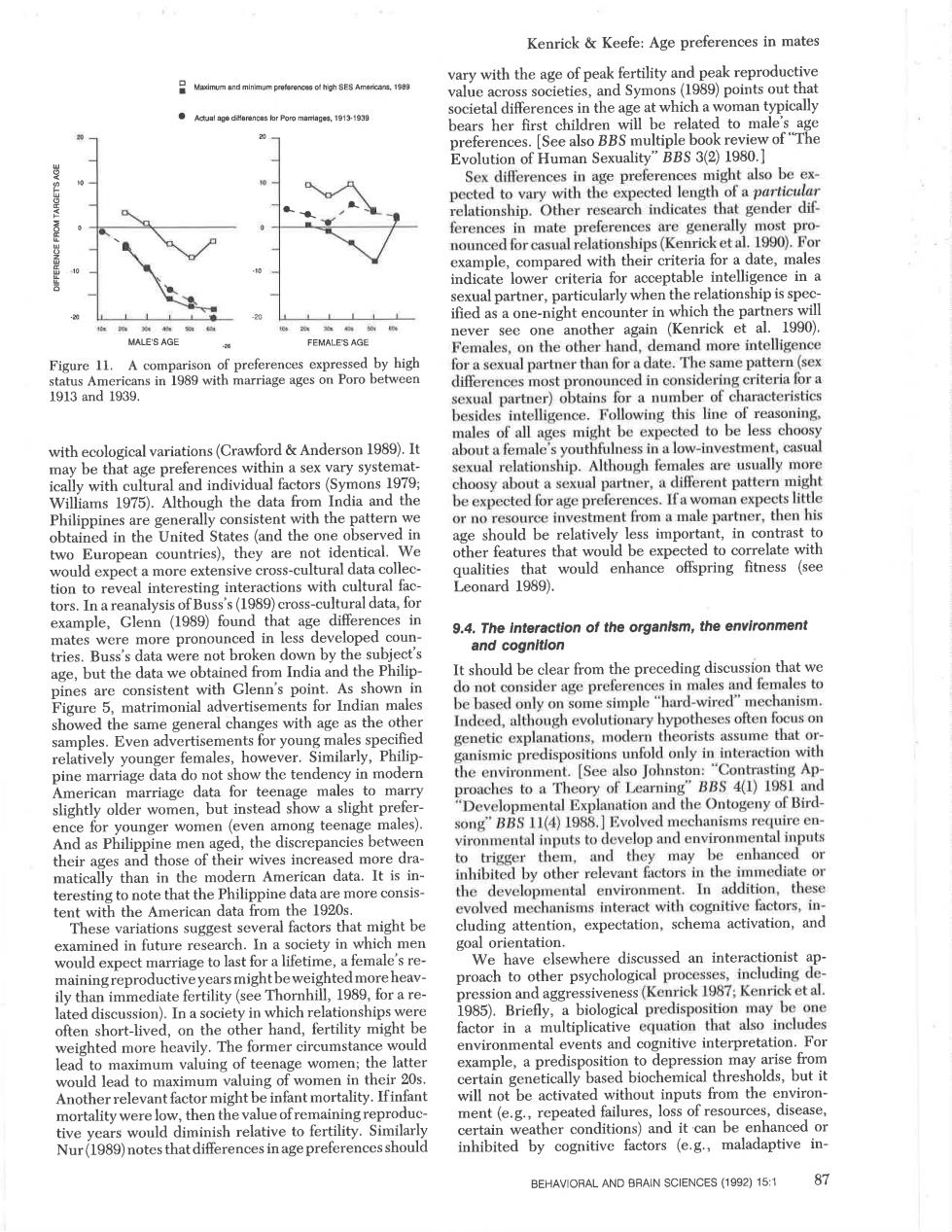
Kenrick Keefe:Age preferences in mates vary with the age of peak fertility and peak reproductive Maximumm and minimum preferences of high SES Americans.1989 value across societies,and Symons(1989)points out that societal differences in the age at which a woman typically Actual age diHerences lor Poro mariages,1913-1939 bears her first children will be related to male's age preferences.[See also BBS multiple book review of"The Evolution of Human Sexuality"BBS 3(2)1980.] Sex differences in age preferences might also be ex- pected to vary with the expected length of a particular relationship.Other research indicates that gender dif- ferences in mate preferences are generally most pro- nounced for casual relationships(Kenrick et al.1990).For example,compared with their criteria for a date,males indicate lower criteria for acceptable intelligence in a sexual partner,particularly when the relationship is spec- ified as a one-night encounter in which the partners will never see one another again (Kenrick et al.1990). MALE'S AGE FEMALE'S AGE Females,on the other hand,demand more intelligence Figure 11.A comparison of preferences expressed by high for a sexual partner than for a date.The same pattern(sex status Americans in 1989 with marriage ages on Poro between differences most pronounced in considering criteria for a 1913and1939. sexual partner)obtains for a number of characteristics besides intelligence.Following this line of reasoning, males of all ages might be expected to be less choosy with ecological variations(Crawford Anderson 1989).It about a female's youthfulness in a low-investment,casual may be that age preferences within a sex vary systemat- sexual relationship.Although females are usually more ically with cultural and individual factors(Symons 1979; choosy about a sexual partner,a different pattern might Williams 1975).Although the data from India and the be expected for age preferences.Ifa woman expects little Philippines are generally consistent with the pattern we or no resource investment from a male partner,then his obtained in the United States(and the one observed in age should be relatively less important,in contrast to two European countries),they are not identical.We other features that would be expected to correlate with would expect a more extensive cross-cultural data collec- qualities that would enhance offspring fitness (see tion to reveal interesting interactions with cultural fac- Leonard 1989). tors.In a reanalysis of Buss's(1989)cross-cultural data,for example,Glenn (1989)found that age differences in 9.4.The interaction of the organism,the environment mates were more pronounced in less developed coun- tries.Buss's data were not broken down by the subject's and cognition age,but the data we obtained from India and the Philip- It should be clear from the preceding discussion that we pines are consistent with Glenn's point.As shown in do not consider age preferences in males and females to Figure 5,matrimonial advertisements for Indian males be based only on some simple "hard-wired"mechanism. showed the same general changes with age as the other Indeed,although evolutionary hypotheses often focus on samples.Even advertisements for young males specified genetic explanations,modern theorists assume that or- relatively younger females,however.Similarly,Philip- ganismic predispositions unfold only in interaction with pine marriage data do not show the tendency in modern the environment.[See also Johnston:"Contrasting Ap- American marriage data for teenage males to marry proaches to a Theory of Learning"BBS 4(1)1981 and slightly older women,but instead show a slight prefer- "Developmental Explanation and the Ontogeny of Bird- ence for younger women (even among teenage males). song"BBS 11(4)1988.Evolved mechanisms require en- And as Philippine men aged,the discrepancies between vironmental inputs to develop and environmental inputs their ages and those of their wives increased more dra- to trigger them,and they may be enhanced or matically than in the modern American data.It is in- inhibited by other relevant factors in the immediate or teresting to note that the Philippine data are more consis- the developmental environment.In addition,these tent with the American data from the 1920s. evolved mechanisms interact with cognitive factors,in- These variations suggest several factors that might be cluding attention,expectation,schema activation,and examined in future research.In a society in which men goal orientation. would expect marriage to last for a lifetime,a female's re- We have elsewhere discussed an interactionist ap- mainingreproductive years might be weighted more heav- proach to other psychological processes,including de- ily than immediate fertility(see Thornhill,1989,for a re- pression and aggressiveness(Kenrick 1987;Kenrick et al. lated discussion).In a society in which relationships were 1985).Briefly,a biological predisposition may be one often short-lived,on the other hand,fertility might be factor in a multiplicative equation that also includes weighted more heavily.The former circumstance would environmental events and cognitive interpretation.For lead to maximum valuing of teenage women;the latter example,a predisposition to depression may arise from would lead to maximum valuing of women in their 20s. certain genetically based biochemical thresholds,but it Another relevant factor might be infant mortality.Ifinfant will not be activated without inputs from the environ- mortality were low,then the value ofremaining reproduc- ment (e.g.,repeated failures,loss of resources,disease, tive years would diminish relative to fertility.Similarly certain weather conditions)and it can be enhanced or Nur(1989)notes that differences in age preferences should inhibited by cognitive factors (e.g.,maladaptive in- BEHAVIORAL AND BRAIN SCIENCES (1992)15:1 87
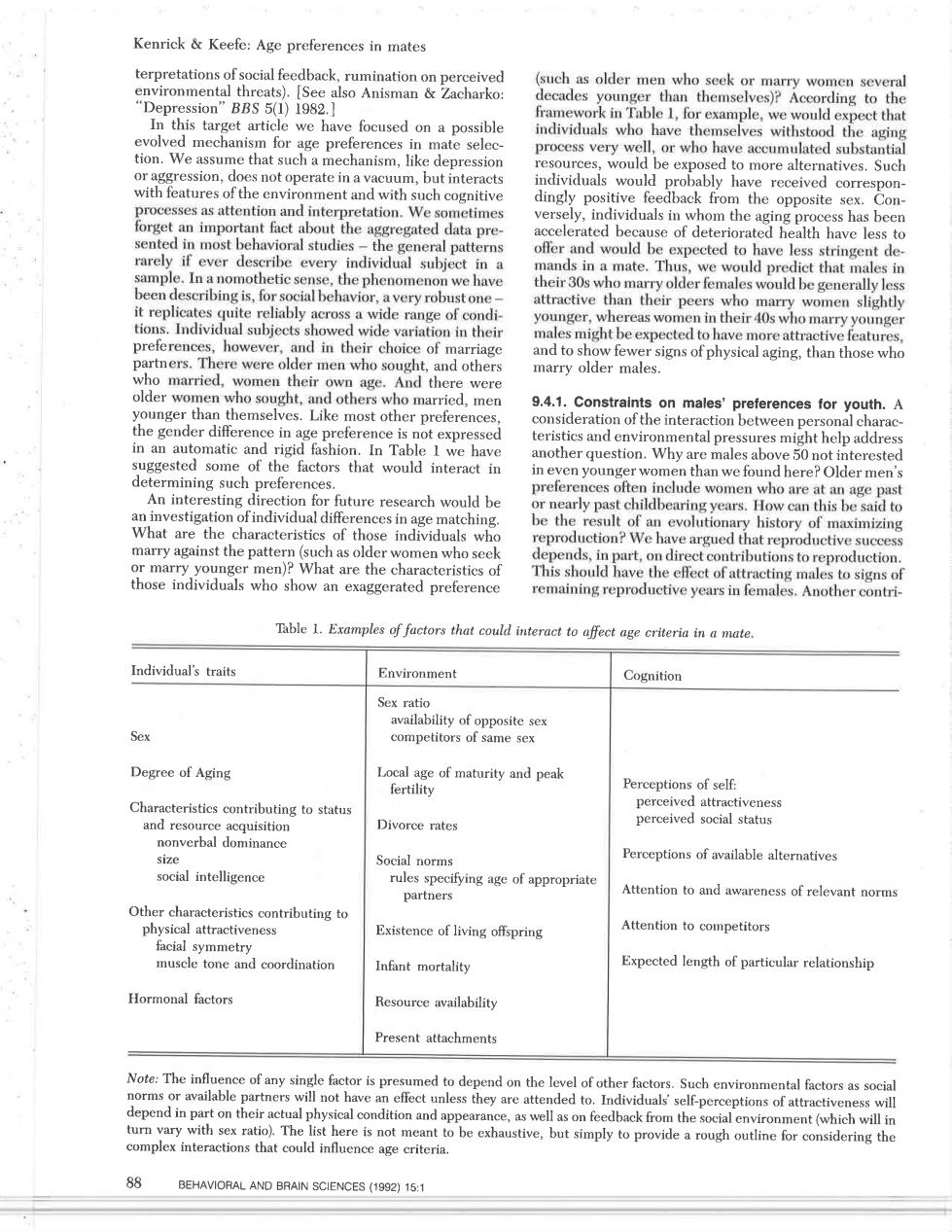
Kenrick Keefe:Age preferences in mates terpretations of social feedback,rumination on perceived environmental threats).[See also Anisman Zacharko: (such as older men who seek or marry women several “Depression”BBS5(1)1982.] decades younger than themselves)?According to the In this target article we have focused on a possible framework in Table 1,for example,we would expect that individuals who have themselves withstood the aging evolved mechanism for age preferences in mate selec- process very well,or who have accumulated substantial tion.We assume that such a mechanism,like depression or aggression,does not operate in a vacuum,but interacts resources,would be exposed to more alternatives.Such with features of the environment and with such cognitive individuals would probably have received correspon- processes as attention and interpretation.We sometimes dingly positive feedback from the opposite sex.Con- forget an important fact about the aggregated data pre- versely,individuals in whom the aging process has been accelerated because of deteriorated health have less to sented in most behavioral studies-the general patterns rarely if ever describe every individual subject in a offer and would be expected to have less stringent de- mands in a mate.Thus,we would predict that males in sample.In a nomothetic sense,the phenomenon we have their 30s who marry older females would be generally less been describing is,for social behavior,a very robust one- it replicates quite reliably across a wide range of condi- attractive than their peers who marry women slightly tions.Individual subjects showed wide variation in their younger,whereas women in their 40s who marry younger males might be expected to have more attractive features, preferences,however,and in their choice of marriage and to show fewer signs of physical aging,than those who partners.There were older men who sought,and others marry older males. who married,women their own age.And there were older women who sought,and others who married,men younger than themselves.Like most other preferences 9.4.1.Constraints on males'preferences for youth.A consideration of the interaction between personal charac- the gender difference in age preference is not expressed teristics and environmental pressures might help address in an automatic and rigid fashion.In Table 1 we have another question.Why are males above 50 not interested suggested some of the factors that would interact in in even younger women than we found here?Older men's determining such preferences. preferences often include women who are at an age past An interesting direction for future research would be an investigation of individual differences in age matching. or nearly past childbearing years.How can this be said to What are the characteristics of those individuals who be the result of an evolutionary history of maximizing reproduction?We have argued that reproductive success marry against the pattern(such as older women who seek or marry younger men)?What are the characteristics of depends,in part,on direct contributions to reproduction. This should have the effect of attracting males to signs of those individuals who show an exaggerated preference remaining reproductive years in females.Another contri- Table 1.Examples of factors that could interact to affect age criteria in a mate Individual's traits Environment Cognition Sex ratio availability of opposite sex Sex competitors of same sex Degree of Aging Local age of maturity and peak fertility Perceptions of self: Characteristics contributing to status perceived attractiveness and resource acquisition Divorce rates perceived social status nonverbal dominance size Social norms Perceptions of available alternatives social intelligence rules specifying age of appropriate partners Attention to and awareness of relevant norms Other characteristics contributing to physical attractiveness Existence of living offspring Attention to competitors facial symmetry muscle tone and coordination Infant mortality Expected length of particular relationship Hormonal factors Resource availability Present attachments Note:The influence of any single factor is presumed to depend on the level of other factors.Such environmental factors as social norms or available partners will not have an effect unless they are attended to.Individuals'self-perceptions of attractiveness will depend in part on their actual physical condition and appearance,as well as on feedback from the social environment(which will in turn vary with sex ratio).The list here is not meant to be exhaustive,but simply to provide a rough outline for considering the complex interactions that could influence age criteria. 88 BEHAVIORAL AND BRAIN SCIENCES (1992)15:1
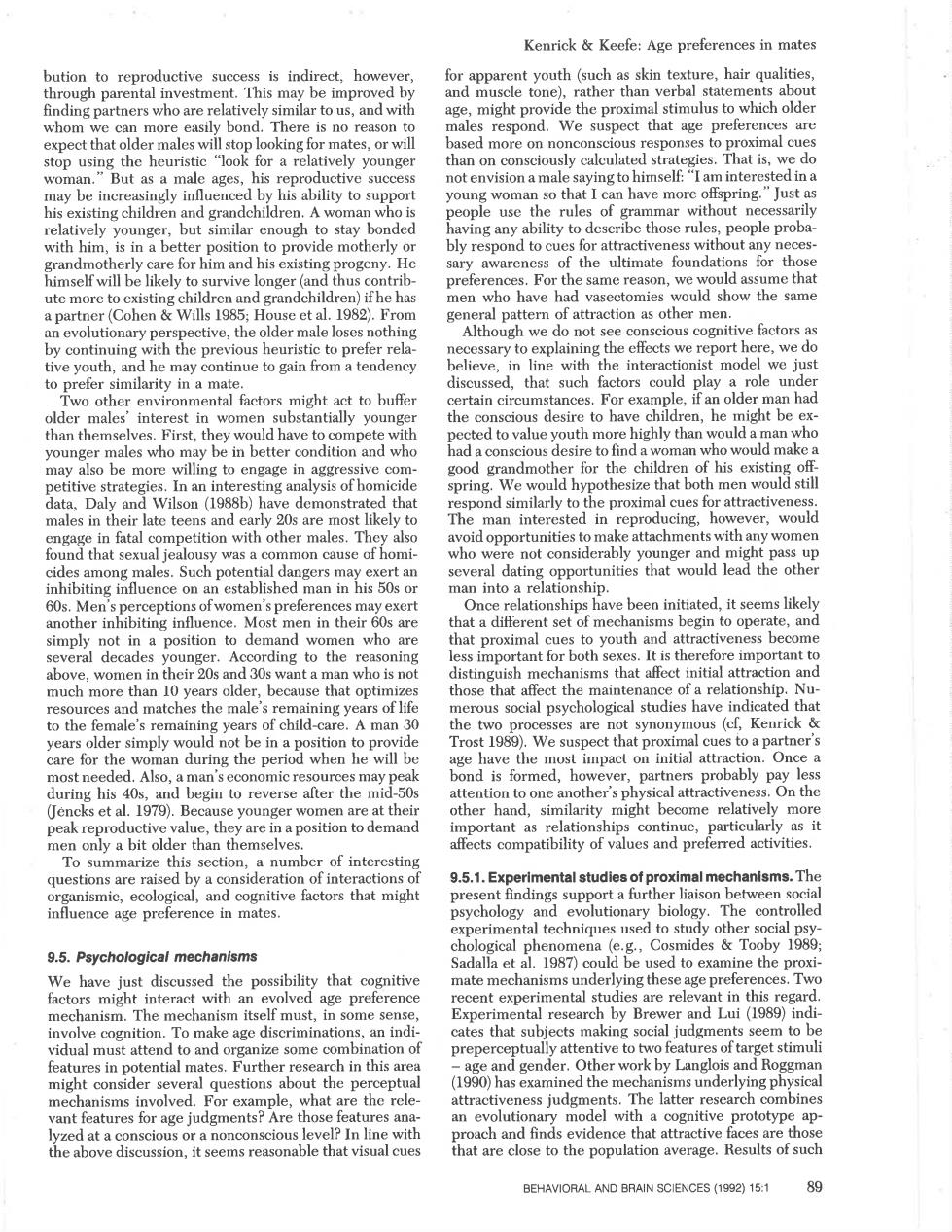
Kenrick Keefe:Age preferences in mates bution to reproductive success is indirect,however, for apparent youth(such as skin texture,hair qualities, through parental investment.This may be improved by and muscle tone),rather than verbal statements about finding partners who are relatively similar to us,and with age,might provide the proximal stimulus to which older whom we can more easily bond.There is no reason to males respond.We suspect that age preferences are expect that older males will stop looking for mates,or will based more on nonconscious responses to proximal cues stop using the heuristic "look for a relatively younger than on consciously calculated strategies.That is,we do woman."But as a male ages,his reproductive success not envision a male saying to himself:"I am interested in a may be increasingly influenced by his ability to support young woman so that I can have more offspring."Just as his existing children and grandchildren.A woman who is people use the rules of grammar without necessarily relatively younger,but similar enough to stay bonded having any ability to describe those rules,people proba- with him,is in a better position to provide motherly or bly respond to cues for attractiveness without any neces- grandmotherly care for him and his existing progeny.He sary awareness of the ultimate foundations for those himself will be likely to survive longer(and thus contrib- preferences.For the same reason,we would assume that ute more to existing children and grandchildren)if he has men who have had vasectomies would show the same a partner(Cohen Wills 1985;House et al.1982).From general pattern of attraction as other men. an evolutionary perspective,the older male loses nothing Although we do not see conscious cognitive factors as by continuing with the previous heuristic to prefer rela- necessary to explaining the effects we report here,we do tive youth,and he may continue to gain from a tendency believe,in line with the interactionist model we just to prefer similarity in a mate. discussed,that such factors could play a role under Two other environmental factors might act to buffer certain circumstances.For example,if an older man had older males'interest in women substantially younger the conscious desire to have children,he might be ex- than themselves.First,they would have to compete with pected to value youth more highly than would a man who younger males who may be in better condition and who had a conscious desire to find a woman who would make a may also be more willing to engage in aggressive com- good grandmother for the children of his existing off- petitive strategies.In an interesting analysis of homicide spring.We would hypothesize that both men would still data,Daly and Wilson (1988b)have demonstrated that respond similarly to the proximal cues for attractiveness. males in their late teens and early 20s are most likely to The man interested in reproducing,however,would engage in fatal competition with other males.They also avoid opportunities to make attachments with any women found that sexual jealousy was a common cause of homi- who were not considerably younger and might pass up cides among males.Such potential dangers may exert an several dating opportunities that would lead the other inhibiting influence on an established man in his 50s or man into a relationship. 60s.Men's perceptions of women's preferences may exert Once relationships have been initiated,it seems likely another inhibiting influence.Most men in their 60s are that a different set of mechanisms begin to operate,and simply not in a position to demand women who are that proximal cues to youth and attractiveness become several decades younger.According to the reasoning less important for both sexes.It is therefore important to above,women in their 20s and 30s want a man who is not distinguish mechanisms that affect initial attraction and much more than 10 years older,because that optimizes those that affect the maintenance of a relationship.Nu- resources and matches the male's remaining years of life merous social psychological studies have indicated that to the female's remaining years of child-care.A man 30 the two processes are not synonymous(cf,Kenrick years older simply would not be in a position to provide Trost 1989).We suspect that proximal cues to a partner's care for the woman during the period when he will be age have the most impact on initial attraction.Once a most needed.Also,a man's economic resources may peak bond is formed,however,partners probably pay less during his 40s,and begin to reverse after the mid-50s attention to one another's physical attractiveness.On the (Jencks et al.1979).Because younger women are at their other hand,similarity might become relatively more peak reproductive value,they are in a position to demand important as relationships continue,particularly as it men only a bit older than themselves. affects compatibility of values and preferred activities. To summarize this section,a number of interesting questions are raised by a consideration of interactions of 9.5.1.Experimental studies of proximal mechanisms.The organismic,ecological,and cognitive factors that might present findings support a further liaison between social influence age preference in mates. psychology and evolutionary biology.The controlled experimental techniques used to study other social psy- 9.5.Psychological mechanisms chological phenomena (e.g.,Cosmides Tooby 1989; Sadalla et al.1987)could be used to examine the proxi- We have just discussed the possibility that cognitive mate mechanisms underlying these age preferences.Two factors might interact with an evolved age preference recent experimental studies are relevant in this regard. mechanism.The mechanism itself must,in some sense, Experimental research by Brewer and Lui (1989)indi- involve cognition.To make age discriminations,an indi- cates that subjects making social judgments seem to be vidual must attend to and organize some combination of preperceptually attentive to two features of target stimuli features in potential mates.Further research in this area -age and gender.Other work by Langlois and Roggman might consider several questions about the perceptual (1990)has examined the mechanisms underlying physical mechanisms involved.For example,what are the rele- attractiveness judgments.The latter research combines vant features for age judgmentsP Are those features ana- an evolutionary model with a cognitive prototype ap- lyzed at a conscious or a nonconscious level?In line with proach and finds evidence that attractive faces are those the above discussion,it seems reasonable that visual cues that are close to the population average.Results of such BEHAVIORAL AND BRAIN SCIENCES (1992)15:1 89